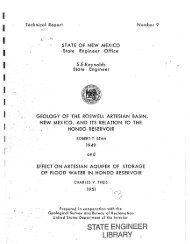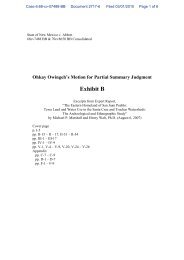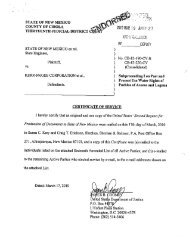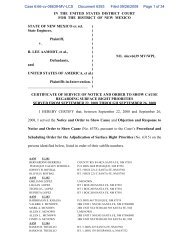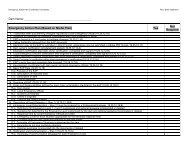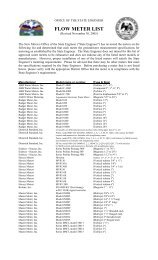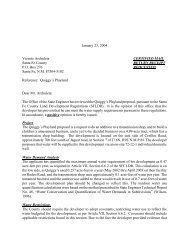The Hydrologic Impacts From the Diversion of Winter Flows of ...
The Hydrologic Impacts From the Diversion of Winter Flows of ...
The Hydrologic Impacts From the Diversion of Winter Flows of ...
Create successful ePaper yourself
Turn your PDF publications into a flip-book with our unique Google optimized e-Paper software.
whe<strong>the</strong>r winter diversions from Cordova Creek for snowmaking<br />
will impact <strong>the</strong> nearest existing water rights.<br />
SNOWMAKING AT SKI RIO<br />
Ski resorts generally produce most artificial snow in<br />
<strong>the</strong> early season and depend upon natural snow through <strong>the</strong><br />
rest <strong>of</strong> <strong>the</strong> season (personal communication, Louis Abruzzo,<br />
Sandia Peak Corp., 1988). Ski Rio's records indicate continuous<br />
snowmaking throughout <strong>the</strong> 1987-88 ski season .<br />
,-<br />
'''''<br />
......... -<br />
U."<br />
'....<br />
,....<br />
r"<br />
Figure 1. "...<br />
I:<br />
....<br />
....<br />
....<br />
...<br />
<strong>From</strong> mid-November to late March approximately 54.5<br />
acre-feet <strong>of</strong> Cordova creek water was diverted for snowmaking<br />
at <strong>the</strong> resort. Ski Rio reported to Mike Pitel, with <strong>the</strong> New<br />
Mexico Economic Development & Tourism Department, that <strong>the</strong>ir<br />
base snowpack was 45 percent below normal for <strong>the</strong> winter <strong>of</strong><br />
1987-88 (Figure 9). Records from <strong>the</strong> New Mexico water Supply<br />
Outlook (May 15, 1988) confirm that snowpack and<br />
precipitation for <strong>the</strong> Rio Grande Basin were below<br />
for late winter 1987-88 (Figure 10).<br />
average<br />
3



